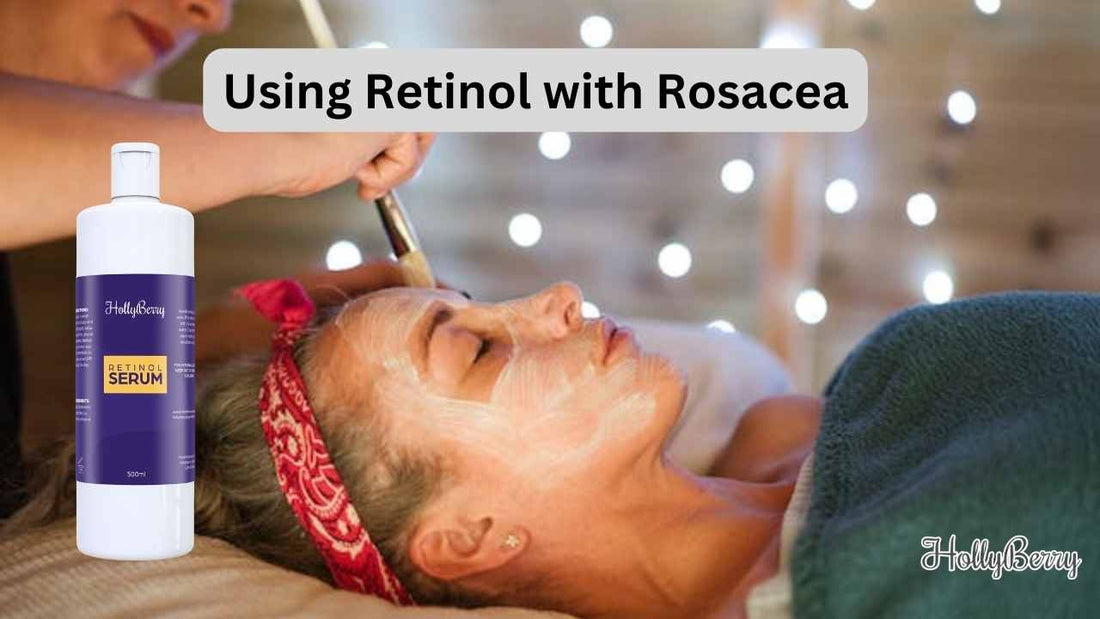
Using Retinol with Rosacea
Share
Safe Practices and Proven Benefits

The use of retinol for those with rosacea can be a complex matter. While it has the potential to improve skin texture and reduce the appearance of pustules, retinol may also cause skin irritation, exacerbating rosacea symptoms such as redness and the appearance of broken capillaries.
As a result, it is essential to approach the use of retinol with caution if you have rosacea.
Before introducing retinol into your skincare routine, it is advised to consult a dermatologist, who can guide you on the appropriate products and concentrations to use. They may recommend a slow and gradual introduction of retinol to minimise the risk of irritation while still reaping its benefits.
By being cautious and seeking professional advice, individuals with rosacea can achieve the best results possible from the use of retinol in their skincare routine.
Understanding Rosacea and Retinol Use
Identifying Rosacea Triggers
Rosacea is a chronic skin condition characterised by redness, inflammation, and sometimes acne-like breakouts. Individuals with rosacea often have sensitive skin, prone to irritation from various triggers.
Common triggers include sun exposure, extreme temperatures, stress, alcohol, spicy foods, and certain skincare ingredients. Identifying and avoiding these triggers can help in managing rosacea symptoms.
Benefits of Retinol for Rosacea
Retinol, a form of vitamin A, is a popular skincare ingredient for its anti-aging and acne-fighting properties. It works by boosting collagen production and promoting cell turnover, which can help improve skin texture and reduce the appearance of fine lines and wrinkles.
In the case of rosacea, retinol may help reduce pustules and uneven texture caused by the condition. However, it is important to note that retinol can also irritate the skin, potentially worsening redness and inflammation for some individuals with rosacea.
Different Types of Retinoids and Their Uses
There are various types of retinoids available in skincare products, ranging from over-the-counter retinol to stronger, prescription-only options like tretinoin.
In addition to retinoids, other treatments for rosacea can include azelaic acid, metronidazole, and ivermectin. These ingredients, often available as prescription topicals, can help with redness and inflammation in rosacea-prone skin.
| Retinoid Type | Uses | Strength |
|---|---|---|
| Retinol | Over-the-counter treatment for signs of ageing and mild acne | Mild |
| Tretinoin | Prescription-only treatment for acne, fine lines, and rosacea | Moderate to Strong |
| Azelaic Acid | Prescription-only treatment for rosacea-related redness and inflammation | Moderate |
| Metronidazole | Prescription-only treatment for rosacea pustules and inflammation | Moderate |
| Ivermectin | Prescription-only treatment for rosacea-related inflammation and pustules | Strong |
Individuals with rosacea should consult a dermatologist to determine the most suitable treatment options.
It is crucial to monitor the skin's response when introducing a new retinoid or other skincare ingredient in a rosacea-prone routine. This can help to minimise the risk of irritation and prevent worsening of the condition.

Buy our Retinol serum
Best Practices and Considerations
Consulting a Dermatologist
When considering using retinol for rosacea, it's crucial to consult with a dermatologist first.
They can provide expert advice on whether retinol is appropriate for your specific skin condition and concerns. Retinol can be beneficial in some cases, but individuals with sensitive skin or severe rosacea may need alternative treatments.
Incorporating Retinol into Your Skincare Routine
If a dermatologist approves the use of retinol, it is essential to incorporate it slowly and cautiously into your skincare routine. Start with a low concentration, gradually increase the frequency of use, and monitor your skin's response.
A gentle cleanser and the regular use of a moisturiser can help maintain your skin's barrier and reduce potential irritation.
Consider the following steps when incorporating retinol into your skincare routine:
- Perform a patch test before general application.
- Apply retinol every third or fourth night initially, and gradually increase to nightly use as tolerated.
- Use a gentle cleanser and moisturiser in tandem with retinol to protect the skin barrier.
- Apply a broad-spectrum SPF of at least 30 daily as retinol can increase the skin's sensitivity to UV rays.
By following these guidelines, you can safely introduce retinol and experience its benefits without exacerbating your rosacea symptoms.
Managing Side Effects and Skin Care Adjustments
While using retinol, it is essential to monitor any side effects and adjust your skincare routine accordingly. If you experience increased redness or irritation, you may need to reduce the frequency of retinol application or experiment with a lower concentration.
Additionally, staying attuned to factors that trigger rosacea flare-ups, such as sun exposure, hot drinks, alcohol, and spicy food, can help prevent potential adverse reactions.
Some lifestyle considerations for managing rosacea effectively include:
- Limiting exposure to known triggers.
- Protecting your skin from UV rays by wearing sun protection clothing and broad-spectrum SPF.
- Reducing stress through relaxation techniques and self-care.
- Avoiding harsh skincare products that exacerbate sensitive skin.
By considering these best practices and following the advice of dermatologists, those with rosacea can successfully incorporate retinol into their skincare routine and ultimately improve the overall appearance and health of their skin.
